Discover the art of David Palumbo, Cartoon Brew's Artist of the Day.
The post Artist of the Day: David Palumbo appeared first on Cartoon Brew.
Add a Comment
Discover the art of David Palumbo, Cartoon Brew's Artist of the Day.
The post Artist of the Day: David Palumbo appeared first on Cartoon Brew.
Add a Comment
Prometheus, a Titan god, was exiled from Mount Olympus by Zeus because he stole fire from the gods and gave it to mankind. He was condemned, punished, and chained to a rock while eagles ate at his liver. His name, in ancient Greek, means “forethinker “and literary history lauds him as a prophetic hero who rebels against his society to help man progress. The stolen fire is symbolic of creative powers and scientific knowledge. His theft encompasses risk, unintended consequences, and tragedy. Centuries later, modern times has another Promethean hero, Alan Turing. Like the Greek Titan before him, Turing suffers for his foresight and audacity to rebel.
The riveting film, The Imitation Game, directed by Morten Tyldum and staring Benedict Cumberbatch, offers us a portrait of Alan Turing that few of us knew before. After this peak into his extraordinary life, we wonder, how is it possible that within our lifetime, society could condemn to eternal punishment such a special person? Turing accepts his tragic fate and blames himself.
“I am not normal,” he confesses to his ex-fiancée, Joan Clarke.
“Normal?” she responds, angrily. “Could a normal man have shortened World War ll by two years and have saved 16 million people?”
The Turing machine, the precursor to the computer, is the result of his “not normal” mind. His obsession was to solve the greatest enigma of his time – to decode Nazi war messages.
In the film, as the leader of a team of cryptologists at Bletchley Park in 1940, Turing’s Bombe deciphered coded messages where German U-boats would decimate British ships. In 1943, the Colossus machine, built by engineer Tommy Flowers of the group, was able to decode messages directly from Hitler.
The movie, The Imitation Game, while depicting the life of an extraordinary person, also raises philosophical questions, not only about artificial intelligence, but what it is to be human. Cumberbatch’s Turing recognizes the danger of his invention. He feared what would happen if a thinking machine is programmed to replace a man; if a robot is processed by artificial intelligence and not by a human being who has a conscience, a soul, a heart.
Einstein experienced a similar dilemma. His theory of relativity created great advances in physics and scientific achievement, but also had tragic consequences – the development of the atomic bomb.
The Imitation Game will open Pandora’s box. Viewers will ponder on what the film passed over quickly. Who was a Russian spy? Why did Churchill not trust Stalin? What was the role of the Americans during this period of decrypting military codes? How did Israel get involved?
And viewers will want to know more about Alan Turing. Did Turing really commit suicide by biting into an apple laced with cyanide? Or does statistical probability tell us that Turing knew too much about too many things and perhaps too many people wanted him silent? This will be an enigma to decode.
The greatest crime from a sociological perspective, is the one committed by humanity against a unique individual because he is different. The Imitation Game will make us all ashamed of society’s crime of being prejudiced. Alan Turing stole fire from the gods to give to man power and knowledge. While doing so, he showed he was very human. And society condemned him for being so.
The post An enigma: the codes, the machine, the man appeared first on OUPblog.
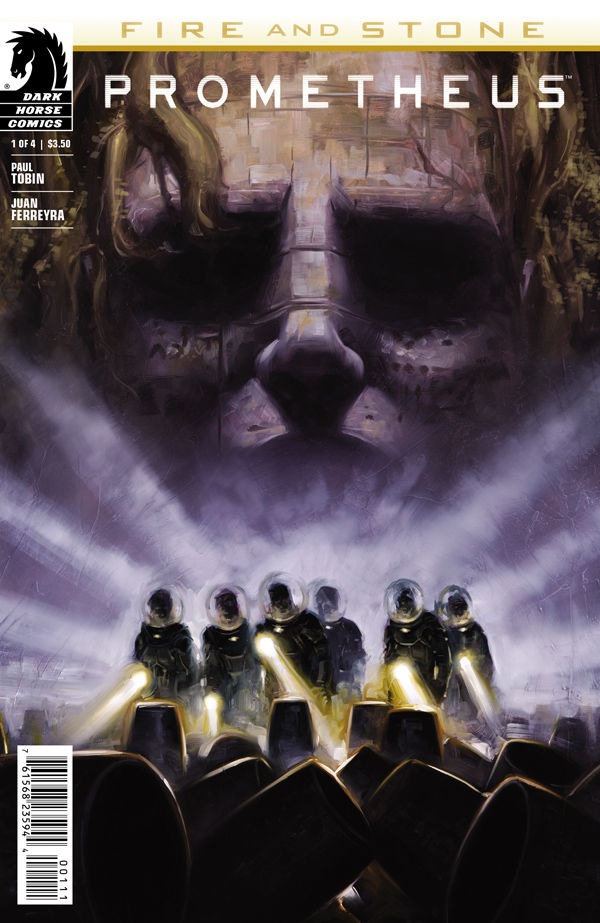
Script: Paul Tobin
Art: Juan Ferreyra
Letters: Nate Piekos of Blambot
Cover: David Palumbo
Variant Cover: Paul Pope, with colors by Shay M. Plummer
Genre: Sci-Fi/Movie Tie-In
Last year, Dark Horse announced they were rebooting their licensed Aliens and Predator comics, launching the first Prometheus series, and tying them all together in a shared universe. That shared universe has arrived with Prometheus: Fire and Stone #1, to be followed by three more Fire and Stone series for Aliens, Predators, and Aliens vs. Predator, respectively. Each series will run four issues, and will conclude with a single, double-sized wrap-up issue.
Reaction to the Prometheus film was divided. It stands at 73% fresh on Rotten Tomatoes, which is a little surprising. Most folks I’ve talked to personally hated the movie, especially fans of the Alien series. But for me, it was a return to form for the series (and universe) launched by Ridley Scott’s initial Alien film in 1979. Prometheus, the film, had retro space suits paired with modern moviemaking sensibilities, themes of cosmic dread and cosmic creation, and questions about where are we going and where we have been. It was majestic and daring science-fiction, populated with compelling characters.
I loved the movie, and I was ready for more.
Prometheus, the comic book, captures the look of its motion picture predecessor, but the first issue isn’t clear about what questions this story is asking. The film wondered where humanity came from, and how its characters would react to the answer. Fire and Stone introduces a new ship (the Helios) and a new crew (including salvagers, documentarians, and an android) who are en route to Moon LV-223, the setting for Prometheus the film. Most of the crew thinks they’re looking for a crashed ship, which the reader knows is the Prometheus of the title. Angela Foster, the Helios’s captain, knows that Peter Weyland himself was aboard Prometheus, and presumably died on LV-223 seeking Engineers, who he believed were the creators of mankind. Angela wants to complete Weyland’s mission.
But why? Captain Foster announces her intention to find answers to one of the many cameras aboard the Helios, but we don’t know why it matters to her. It’s true that Fire and Stone is simply the first issue of not only a four-part series, but also of an entire line of shared-continuity books, but in the first act of Prometheus the film, we understood that Elizabeth Shaw, played by Noomi Rapace, had a belief in God that was sometimes in opposition to her scientific beliefs. Meredith Vickers, played by Charlize Theron, was a Weyland Corporation representative there to enforce the rules even as she clashed with David, Michael Fassbender’s android, who chased after human affectations and modeled his speech patterns after Peter O’Toole’s Lawrence of Arabia.
In contrast, Fire and Stone’s characters sometimes reveal bits of backstory — the captain keeps her true purpose on LV-223 a secret, the astrobiologist has a mysterious illness, the documentarian is romantically involved with a member of the crew — but there are no compelling character moments in this issue. Even if Captain Foster’s job is to simply complete Peter Weyland’s mission, an implied “me too!” is not a very compelling character motivation.
But at least in the absence of rich characters worth investing in, Fire and Stone offers an interesting plot. After a one-page prologue set in the time period of the film, the comic jumps ahead to the year 2219, roughly 130 years after the Prometheus the film and about 40 years after the events of Aliens and Alien³. When the salvage crew of the Helios lands on LV-223 — though there is some uncertainty on their part if they’ve landed on the right moon — they find a world that has been irrevocably changed by the events of the film. It’s different from the LV-223 we’ve seen before, but it’s still recognizable as existing in the Aliens universe. The Helios crew explores with even less care than their Prometheus counterparts, which will surely enrage the same segment of the audience who thought the Prometheus crew were crazy for taking their helmets off, breathable atmosphere or no. But this seems consistent with the Weyland-Yutani protocols (or lack thereof) for exploring new worlds that we’ve seen in the films. The characters make bad decisions, which leads to dangerous situations, which is another hallmark of stories set in an Alien universe.
Juan Ferreyra’s art is another high mark for the book. There are a lot of Helios crewmembers introduced in just a few pages, and their depictions remain clear and consistent throughout. The illustration and coloring styles (and the spacesuits) remind me of European sci-fi comics in the vein of Métal Hurlant. The colors in particular are crisp and bright, which is something I’ve come to expect from recent Dark Horse books. Once the Helios lands and the crew leaves the ship, the book reveals LV-223 mostly through two-page spreads, breaking away from the single-page claustrophobia of the scenes set on the ship, an effective way to pull the reader’s attention across the expanse of a strange and unexplored world.
Paul Tobin is the only credited writer in the advance review copy I received, but much of the press for this shared universe reboot talks about the “writers room” approach to all of the books. Tobin is joined by Chris Roberson on Aliens, Joshua Williamson on Predators, Chris Sebela on Aliens vs. Predator, and Kelly Sue DeConnick on the crossover finale issue, and as the group’s lead writer. Tobin’s Prometheus is designed to be “the warm, beating heart of all of these books,” according to AvP’s Sebela in an October 2013 interview with io9. Which might be true, but in addition to jumping the Prometheus story into the timeframe of the Alien films, the tone and atmosphere of this issue is much closer to stories about xenomorphs than the one we’ve seen about Engineers. “Why are we here?” is replaced with “Get out of there fast!” as the “beating heart” of this story’s engine.
That could be great news if you loved the Alien quartet of films and were disappointed in Prometheus’s ties to the series. But for anyone looking forward to Prometheus, the comic, carrying on the spirit of Prometheus, the film, it’s a disappointment.
 By Kyle Pinion
By Kyle PinionDark Horse Editor in Chief Scott Allie has pulled together a wide array of young and up and coming talent for the upcoming four interlocking mini-series that revolve around the Aliens, Predator and Prometheus franchises entitled “Fire and Stone”. The majority of those creators joined him on stage for Dark Horse’s panel on the subject and included Paul Tobin (Prometheus), Chris Sebela (Aliens vs. Predator), Chris Roberson (Aliens), Joshua Williamson (Predator), Juan Ferrerya (Prometheus), and Ariel Olivetti (Aliens vs. Predator).
While the majority of the discussion held therein was for the most part news that has already been reported in the previous months leading up to the end of year release of this long-anticipated “mega-series”. There were a number of items worth noting:
- The collaborative process between the entire team has been a smooth one, despite a significant bump caused by notes given by Fox and Ridley Scott’s team regarding some of the content and the narrative direction of the series, causing much of each creative teams’ work to be scrapped. Though Tobin made note that the studio has now opened up “more of the tool-box” for their usage.
- This change of direction from Fox is one of the major factors that caused the eventual release delay of each series.
- Originally, Williamson was slated for an Aliens comic before the “Fire and Stone” concept came into place, and while he was sad to see the take that he and Allie had worked out not see the light of day, he believes this new effort is equally as exciting.
- Each team member stressed that the chemistry of their writers’ room approach was a big part of why this project came together as well as it did, despite significant rewrites being needed.
- Kelly Sue DeConnick, who is also writing the finale of the series in Prometheus Omega, was credited as the key driver of research regarding incorporating Prometheus into the Alien and Predator universe. According to Allie, she brought an entire pink binder full of Prometheus theories from the internet.
- Ferrerya was brought on board to the project because of his design skill, and that was an angle that the team wanted to make sure was highlighted. Roberson likened Ferrerya’s map-making abilities to being “one step away from a DnD campaign”.
- Paul Tobin was brought in for the Prometheus series because of his previous work with Ferrerya on Colder.
- Williamson discussed the eponymous Predator of his Predator series, named Ahab, who is indeed hunting for a “white whale” though the identity of said target had to remain a secret. He also was proud of the fact that Ahab already has an action figure, which could be found at the Dark Horse booth on the show floor.
- Williamson also discussed his protagonist, Galgo, who will be appearing in Prometheus first, followed by Aliens v Predator, eventually becoming the lead in Predator. The writer made sure to mention the morally grey nature of the character, and also his verbose nature.
- Sebela, regarding Aliens vs. Predator, stated that he spent his entire childhood trying to figure out a way for Xenomorphs and Predators to fight and couldn’t pass up the opportunity to do the same in comics. Allie felt as though Sebela’s horror background was a particularly strong fit for the “monster-like” material in his series. Olivetti expressed excitement for the cinematic nature of the visuals he is producing, a first for him in comics.
- When asked if the stories connect, the team stressed that the books could be read independently of one another and readers could get a satisfying story that way, but they would see the larger picture form if they wanted to read the entire event.
- The chronology of “Fire and Stone” was also cleared up, as Aliens is a pseudo prequel to the other tales, and takes place between scenes of Aliens (the film), Predator takes place after the other minis and Prometheus Omega is the finale.
- In response to a question regarding previous usage of “The Space Jockey” and the mythos built around it in previous Dark Horse Aliens comics, Allie said those stories will not come into play with Fire and Stone.
- Bouncing off of that, Roberson made mention that the key directive was to “start from the films and go from there”, and the only films that team really concentrated on were: Prometheus, Alien, Aliens, and Predator. Sebela, when asked, said that the two Aliens vs. Predator films were not canon to his series.
- When the divisive nature of Prometheus amongst fandom was brought up, Paul was quick to point out that he wasn’t interested so much in leaving any elements of that film behind, so much as he wanted to highlight the parts of it that worked well, specifically the concept of scientists going on a mission and realizing that things are far bigger than they ever imagined. Ferrerya then joked that he was excited to bring back the biologist and cartographer characters that everyone “loved” from the film.
- Allie made sure to underline that theme was key driver in the storytelling of each mini-series, particularly the idea of the “stewardship of life”, which runs in the background of the Alien and Prometheus films particularly. Roberson also made mention that the parallels that run between the androids in Aliens and Prometheus was a major influence.
- And yes, there will be Black Goo! Which, according to Roberson’s read of the notes they received from Fox, is called “accelerant”. They declined to go into further detail regarding the role it will play in the stories themselves.
- Prometheus and Aliens will both be due out in September, Aliens vs Predator and Predator will see release in October. The Prometheus Omega one-shot is set to arrive in February. Each series will be a 4-issue mini respectively.
One of the real breakout comics of 2013 was Bandette, from the husband and wife team Colleen Coover and Paul Tobin. A digital comic that is creator-owned and sold by Monkeybrain for only 99¢, the tale of young Parisian cat-thief Bandette and her team of accessories has been a hit both creatively and commercially. Awarded the Eisner Award for best digital comic, while nominated in three other categories, Bandette is a great example of the digital first/print second phenomenon in comics, with the first five issues released in hardback form by Dark Horse last November. Coover and Tobin, both of whom have long and esteemed resumes in comics where very kind to submit to an interview from me, to catch up on how things have gone for them and the title since the big Eisner win at Comic-Con in San Diego.
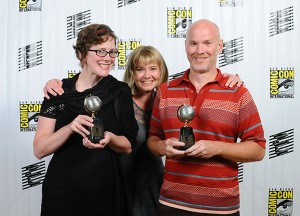
Colleen Coover and Paul Tobin, with Allison Baker of Monkeybrain
BRUCE: I got to speak with you guys in San Diego the day before the Eisners. How did it feel to win for Bandette, and has the award changed how people perceive you and your work? Did it have a noticeable effect on Bandette sales?
PAUL: It felt strange to win an Eisner. There was a moment after the announcement when I just froze in confusion, and then I apparently teleported up onto the stage, and it really wasn’t until I was looking at Colleen that I understood we had won. Luckily, even while still on stage I was able to reflect how wonderful, and how rare, it is to be holding an Eisner in my hands, and watching my wife accept an Eisner as well. And it’s definitely heightened awareness (and sales) of my other works, and of course Bandette itself. It’s just great that of the four nominations, we won the first one announced, because that allowed us to be truly happy for our friends when they won. Our friend Chris Samnee winning best artist over Colleen? No problem, because we already have an Eisner on the table!
COLLEEN: The euphoria really was heady. The only drawback, if it can be called a drawback, is that since winning the award, I’ve felt an added sense of responsibility about making Bandette even more awesome. It’s like, “Okay, you’ve given us this thing and we like it, here’s your reward. Now what else have you got?” I should say that this sort of inner dialog is all part of the necessary balance between swagger and self-doubt every creative professional must have in order to keep motivated.
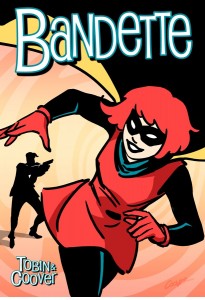
BRUCE. You guys are such a great example of the digital first-print second phenomenon with the release of the Bandette hardcover in November. How has that experience been? Are you happy with the reception of the hardcover, critically and commercially?
PAUL: Definitely happy. We chose Dark Horse because they’d done such a fantastic job on the Bucko hardcover by our friends Erika Moen and Jeff Parker, and they did an equally great job with Bandette. We wanted to make sure it looked like something that belonged on a shelf, or on display.
COLLEEN: Yeah, also, Dark Horse made it really clear that they wanted to be the print publisher for Bandette, and that they would work with us to make sure that it not only looked great, but came in at an affordable price point. I don’t know what the sales numbers are, but we hear from people every week who have picked up Bandette and love it!
BRUCE. While I’m sure there is no way to know with certainly, but what is your impression of the hardcover purchasers? Are they primarily the same audience as the digital purchasers, but now looking to own a tangible artifact? Or is it a whole new audience that was not interested in the comics as digital purchases?
PAUL: Both. We’ve had plenty of readers contact us and say that they loved the digital comic so much that they were thrilled to have a hardcover, and then there were others who wrote to say how happy they were to have the hardcover, because reading comics digitally either didn’t appeal to them or that they just didn’t have access. I think it was the right way to go for us; it’s not even a “best of both worlds” situation, because it’s “both worlds” straight up.

BRUCE: What have you guys learned from the hardcover experience so far? Is there anything you might do differently next time?
COLLEEN: Fortunately, Dark Horse has so much experience publishing good-looking books, all we had to do was sit back and make approvals. They were even able to accommodate a totally last-minute change I wanted to make to the frontispiece when I suddenly got the idea to put in a “This book belongs to…” bookplate.
PAUL: Really… we were quite happy. Sometimes the best thing to do is to relinquish a bit of control and let things happen. Of course, you can guide the process, and we certainly did that, because it still needs to feel like it’s “yours” at every step of the process.
BRUCE: Top Shelf just announced a program by which purchasers of select print titles can also get the digital version for a heavily discounted price. Is that something you might offer, or would it be too complicated with two different publishers, Monkeybrain and Dark Horse?
PAUL: Individual issues of Bandette are already only 99 cents, so I think that’s pretty cheap!
COLLEEN: And yeah, it would be difficult contractually, since Monkeybrain holds exclusive digital rights and Dark Horse has the print rights. I do think it’s a very good business model to include ebooks with the sale of print titles.
BRUCE: Are there plans for a paperback version? Do you have a longer term plan to release print versions for every 5 individual Bandettes? Are you contracted to return to Dark Horse for future print releases or can you make new partnerships on a book by book basis?
PAUL: We’ve talked about a paperback version, but it’s not something we think it heavily needed. We worked really hard to produce not only a great looking hardcover, but to keep the price VERY low, so it’s a 144 page hardcover for only $14.99, so a paperback isn’t a pressing need. There will be more hardcovers up-coming, but I’m not sure exactly how many issues will be in each one. Storylines will help determine that.
BRUCE: What kinds of things did you specifically do to keep costs down? Do you have advice for other creators looking to convert digital properties to print?
COLLEEN: That’s all secret Dark Horse economic jujitsu at work: Paper stock, book size, number of colors used to print certain pages– every little bit you can save without making it look like you’ve held something back adds up.
BRUCE: The hardcover is beautifully printed, and the colors especially pop out from the page. Has the experience of seeing Bandette in print changed anything in your approach to the digital production? Are you still wedded to the three panel page layout that you’ve done so far with Bandette?
PAUL: We love the three tier approach to comics, at least for this project, because it’s not only handy for digital, but also an homage to the comics we’re emulating to a certain degree… Tintin, for instance. And, it has such a clarity that I think it lends itself well to the stories.
COLLEEN: It ain’t broke, so I’m not looking to fix anything!
BRUCE: I really enjoyed Colleen’s work on Batman ’66. How did it feel to work with Jeff Parker as writer after having done so much work with Paul? Did you enjoy the experience of creating art for the Guided View style of digital comic, as you previously told me it would not work with Bandette? Did it change your mind on that?
PAUL: This question is not about me, and is therefore invalid.
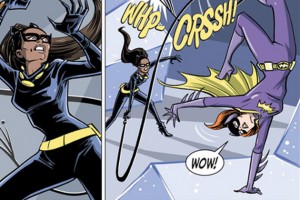
COLLEEN: I’ve worked more with Parker than with anyone other than Paul, back when we were doing stuff for X-Men: First Class, so it was a very familiar place to be. We work together in a totally different way from the way Paul and I work: Paul will present me with a complete script, and then he steps back and I draw it. With Parker, we’ll spend time hanging around in the studio, talking about old comics, and ideas for the story he’s going to write for me come out of that. When Jeff found out he was getting the Batman ’66 job, we spent hours reminiscing about watching the TV show when we were kids in the 70s. A lot of the stories he’s written springboard directly off those conversations.
As for the enhanced view, Jonathan Case, who was the first artist on Batman ’66, and is also in our studio, did a lot of the legwork on figuring out how to make it happen without driving himself crazy, and I picked up some tips from him. For starters, we both drew our stories digitally, so that the little changes that happen in each panel match up precisely. The kicker is that no matter what additional “action” we put in the story for the digital product, there has to be a final printable version that makes sense when they publish the story in the comic. It’s a real storytelling challenge, and it was a ton of fun!
BRUCE: In San Diego you told me that a Pixar version of Bandette would be a dream come true. Have had any more thoughts or approaches to put Bandette in other media? I believe there are Bandette T-shirts for sale, but merchandise could be a way to further monetize your digital property, I imagine?
PAUL: So far we’ve done very little on the merchandising front, mostly because we haven’t had time to set everything up, but we do have some thoughts about Bandette in other media. I guess, for right now, we’re just trying to really get our own feet on the ground and establish Bandette, before we start looking to expand.

COLLEEN: Yeah, I set up some tees and mugs and phone cases on Café Press and on Zazzle, which is about the bare minimum of effort you can make to provide mech. Merchandizing is a lot of work, and requires monetary investment, so we’re going to wait and see what opportunities come up from people who do that sort of thing for a living, rather than try to do it ourselves. I’m still very open to Pixar doing a Bandette film. Or really, any other studio.
BRUCE: I know Paul has the new Prometheus comic scheduled for release in June. I would assume Dark Horse is kind of feeling the heat in regards to licensed properties now that Star Wars is no longer theirs. How has the experience been so far? It must take quite a change of mental pace to go imaginatively from Bandette‘s whimsical Paris to the rather grim planet LV-223! And that is not a cross-over I would want to see! ;)
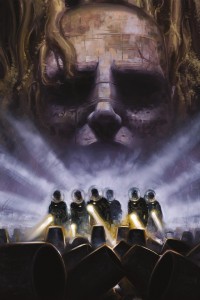
PAUL: It’s going to be later than June, because we want to match some things up, but… yeah, it’s been a blast. I’m working with three other local writers on the project, each with our own book. There’s me on the lead title, Prometheus, and then Chris Roberson on Aliens, and Josh Williamson on Predator, and Chris Sebela on Aliens vs. Predator. It’s great because we’re all local, and all friends, so we can get together a lot, talk about the project and eat cake. As far as the change of mental pace between projects, I’m really all over as a general rule. I just finished an Adventure Time series, a Plants vs. Zombies project, a whole bunch of writing for Angry Birds, and of course Bandette, and that’s all fairly light-hearted material. At the same time, I’m working on my Colder horror series, and Prometheus, and the Witcher comics for Dark Horse… all much darker. My upcoming novels are much the same: you’ll see some humor titles, and then some darker material. I actually find it easier to work in several areas. It keeps my brain bouncing, moving from one project to the next, so that I don’t grow stale and predictable.
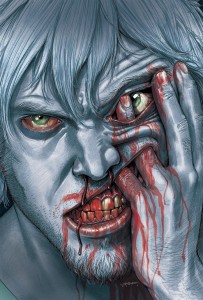
BRUCE: Do you have a philosophy or even rule of thumb that you use to guide what projects you take on, specifically in the realm of balancing personal/independent projects with more commercial properties? Does the success of Bandette allow you more freedom in pursuing your projects?
COLLEEN: Last spring, right as I was finishing up Bandette #5, I had two short projects I had committed to previously come due. Once those were done, I was going to get right back to Bandette, but then the Batman ’66 gig came available. Any other project, I would have turned down, but the Batman TV show was just too big a part of my early life to pass on that opportunity. As a result, there was rather a long wait for Bandette #6. Now, I’m focusing entirely on Bandette. No other projects are being considered.
BRUCE: And one more question, with Bandette #6 out, when can we expect #7? Are you guys hoping to maintain a consistent schedule of issues in 2014? And the Urchin stories have been so fun, with #9 now available from the Monkeybrain site. Any artist names of future Urchin stories you want to tease your readers with?
COLLEEN: Bandette #7 is about a week from being colored and finished now, at the end of February, and then it takes several weeks for Comixology to get it ready to go live. As for our schedule, we will continue to put out issues as quickly as I can draw them!
Urchin artists of the future include but are not limited to: Sheli Hay, Ron Chan, Dylan Meconis, Ron Randall, Cat Farris, Emi Lenox, Steve Lieber, and Juan Ferreyra.
Bruce: Thanks very much!
Our fascination with creativity is a timeless and universal phenomenon. Since Greek antiquity, its most telling embodiment has been Prometheus: that heroic benefactor of humanity who stole the fire whose vital sparks sustain science and the arts. In more modern times, it is the fire of the imagination that is understood to illuminate and guide the creative mind, transforming the conventions of culture. For Ludwig van Beethoven, at the threshold of the nineteenth century, the challenge retained its force: his first major piece for the stage was the ballet music to “The Creatures of Prometheus,” op. 43. That work in turn became the stepping-stone to a pivotal masterpiece of fiery daring: the Eroica Symphony, completed in 1804.
In the world of art, the notion of a work emerging through long toil and unfailing vision is perhaps most readily associated with sculptors such as Michelangelo or Rodin. A prolonged creative process with intermediate stages in the form of models, studies, sketches, and earlier versions, is illustrated in the work of Leonardo da Vinci and many others. Among writers, one thinks of Goethe’s long preoccupation with Wilhelm Meister or Faust, or Jean Paul Richter’s prolonged work on his novels.
Beethoven’s labors on major projects could extend over many years and even decades of his life, with certain compositions serving as stepping-stones toward larger comprehensive efforts. Thus the Choral Fantasy, op. 80, from 1808, acted as a springboard in the achievement of the choral finale of the Ninth Symphony, completed in 1824. Beethoven himself pointed out the affinity, describing the finale as “a setting of the words of Schiller’s immortal ‘Lied an die Freude’ in the same way as my pianoforte fantasia with chorus, but on a far grander scale.”In the age of Romanticism, the emphasis on originality and the cult of genius raised the stakes of artistic creativity, and propagated the image of the suffering artist-hero. Beethoven’s reputation for defiant independence fit this heroic image and his handicapped status as a “deaf seer,” in Wagner’s words, made it stick. With Beethoven’s worsening deafness came an inevitable retreat from the concert platform as well as an increasing social isolation. His loss of hearing also impacted his composing methods. As he grew older, Beethoven relied more on written musical sketches and drafts. As a young composer who was also an active keyboard virtuoso and skilled improviser, Beethoven could immediately test ideas at the piano. Increasingly, such exploratory activity was transferred from the piano to his sketchbooks and thereby captured on paper, with the musical sketches sometimes taking on the appearance of notated improvisations.
The legacy of Beethoven’s sketchbooks offers us a rare opportunity to gaze into the workshop of one of the greatest artists. Beethoven made thousands of pages of sketches and drafts for his music in addition to the finished scores, many of which are also full of his changes and corrections. This process of writing traced both the swift arc of the imagination and the very conscious deliberation demanded by specific compositional problems. His unusual and consistent reliance on these papers and attachment to them after use have preserved a detailed record of the creative process.
Beethoven’s commitment to sketching his music was noticed and remarked upon by his contemporaries. Ignaz von Seyfried, for instance, reported that Beethoven “was never found on the street without a small note-book in which he was wont to record his passing ideas. Whenever conversation turned on the subject he would parody Joan of Arc’s words: “I dare not come without my banner!”
How can we best do justice to Beethoven’s legacy and influence in the present day? One imperative is to seek to overcome narrow or overspecialized approaches that sever history from theory, and performance from aesthetics. Such pigeonholing is often encouraged by institutional structures, but often does not help us to grasp the magnitude of Beethoven’s achievement and continuing cultural importance. Beethoven once wrote characteristically about the need for “freedom and progress. . . in the world of art as in the whole of creation.” To refer to his own artistic goal in this context he coined the term Kunstvereinigung or “artistic unification.” Today, two-hundred forty-two years after his birth, Beethoven scholarship is entering its most vigorous stage yet, influencing our contemporary musical and cultural life.
William Kinderman is Professor of Musicology at the University of Illinois – Champaign-Urbana. His books include Beethoven’s “Diabelli” Variations (OUP, 1987), ed., Beethoven’s Compositional Process (Nebraska, 1991), Beethoven (OUP and California, 1995), ed., The Second Practice of Nineteenth-Century Tonality (Nebraska, 1996), Artaria 195: Beethoven’s Sketchbook for the ‘Missa solemnis’ and the Piano Sonata in E Major, Opus 109 (Illinois, 3 vols., 2003), ed. (with Katherine Syer), A Companion to Wagner’s “Parsifal” (Camden House, 2005), ed., The String Quartets of Beethoven (Illinois, 2006), and Mozart’s Piano Music (OUP, 2006). He is also an accomplished pianist whose recordings have been met with global acclaim; his CDs of Beethoven’s last sonatas and Diabelli Variations have appeared with Arietta Records.
Subscribe to the OUPblog via email or RSS.
Subscribe to only music articles on the OUPblog via email or RSS.
The post Beethoven’s creativity in the 21st century appeared first on OUPblog.
I recently sat down to add an oldie but a goodie to my library, Mary Shelley's Frankenstein. I don't know how I managed, but I missed this one in high school and college. After finishing it last night, I am in awe.
Compelling characters? I remember uncharismatic “scientists” being sad and complaining about having to do stuff like leave their ship to explore new worlds . :P
Prometheus was a good looking film, no denying that. The problem was that the script was bad like a lot of comic summer crossovers are bad: plotholes, shaky characterization, more plotholes, and the many logical issues that arise when you give the story more than 10 seconds of thought. My favorite one was how the surgery unit in Charlize Theron’s room was somehow programmed to only operate on dudes.
” My favorite one was how the surgery unit in Charlize Theron’s room was somehow programmed to only operate on dudes.”
LOL, That whole movie was “Because PLOT”.
The Pauling Medpod was there for Weyland and Weyland only. The old man didn’t give a damn about her daughter – or anybody else.
My personal version of hell would be watching “Prometheus” over and over and over.